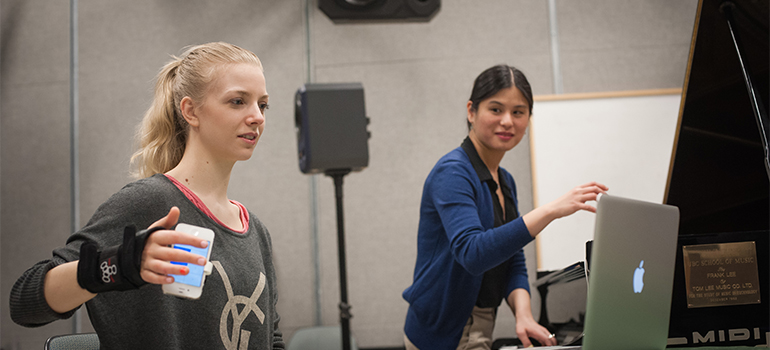University of British Columbia music professor Bob Pritchard has seen enough uninspiring laptop music sets to know what is wrong with the genre - backing tracks can only take you so far - and has an idea how to fix it.
Pritchard and UBC’s Laptop Orchestra believe digital cameras and other gadgets might just save live electronic music from itself - so they did a concert without actually touching their laptops.
“That’s one of our rules,” says Pritchard, “Avoid touching the laptop!”
Instead, the 17 students acted as musicians, dancers, composers, programmers and hardware specialists and created electroacoustic music using body movements. They strapped motion sensors to their bodies and instruments, played wearable iPhone instruments, swung Nintendo Wiis or PlayStation Moves, while Kinect video cameras from Xbox tracked their movements.

Pieteke MacMahon rehearses with an iPhone Piano app developed by members of UBC’s Laptop Orchestra. Photo: Martin Dee
2014, with its "I can't do math" liberal arts identification, doesn't see a lot of collaboration between engineering and music students. UBC recognizes that it makes liberal arts students ill-prepared for the real world, where technology rules and creative has to convey it to the public, which takes a great deal of understanding.
Along with music, the students have created a series of interfaces and musical gadgets, such as sensorUDP, which transforms musicians’ smartphones into motion sensors. It allows performers to layer up to eight programmable sounds and modify them by moving their phone.
Music student Pieteke MacMahon modified the app to create an iPhone Piano, which she plays on her wrist, thanks to a mount created by engineering classmates. As she moves her hands up, the piano notes go up in pitch. When she drops her hands, the sound gets lower, and a delay effect increases if her palm faces up. “Audiences love how intuitive it is,” says the composition major. “It creates music in a way that really makes sense to people, and it looks pretty cool onstage.”
Credit: UBC
Earlier this year, the ensemble went to Europe and spent 10 days in Belgium, where they collaborated and performed in concert with researchers at the University of Mons, a leading institution for research on gesture-tracking technology.
In Belgium, the ensemble’s dancer Diana Brownie wore a body suit covered head-to-toe in motion sensors as part of a University of Mons research project on body movement. The researchers – one a former student of Pritchard’s – will use the suit’s data to help record and preserve cultural folk dances. The third-year Psychology student says the ensemble’s motion technology helps non-musical collaborators feel more part of the show. “As a dancer, the music typically dictates your movements,” Brownie says. “But with this, your dancing create the sounds – so it’s been a really great experience.”
Credit: UBC
“Recording artists need to support themselves through their live shows,” says Kiran Bhumber, a fourth-year music student and clarinet player. “It blows people’s minds to see music created this way, so the technology helps set me apart from other artists. And economically, I can work solo or in small groups, which makes touring viable. I just pack my laptop, my clarinet and some sensors, and hit the road.”
Source: The new pulse of digital music by Basil Waugh, UBC






Comments